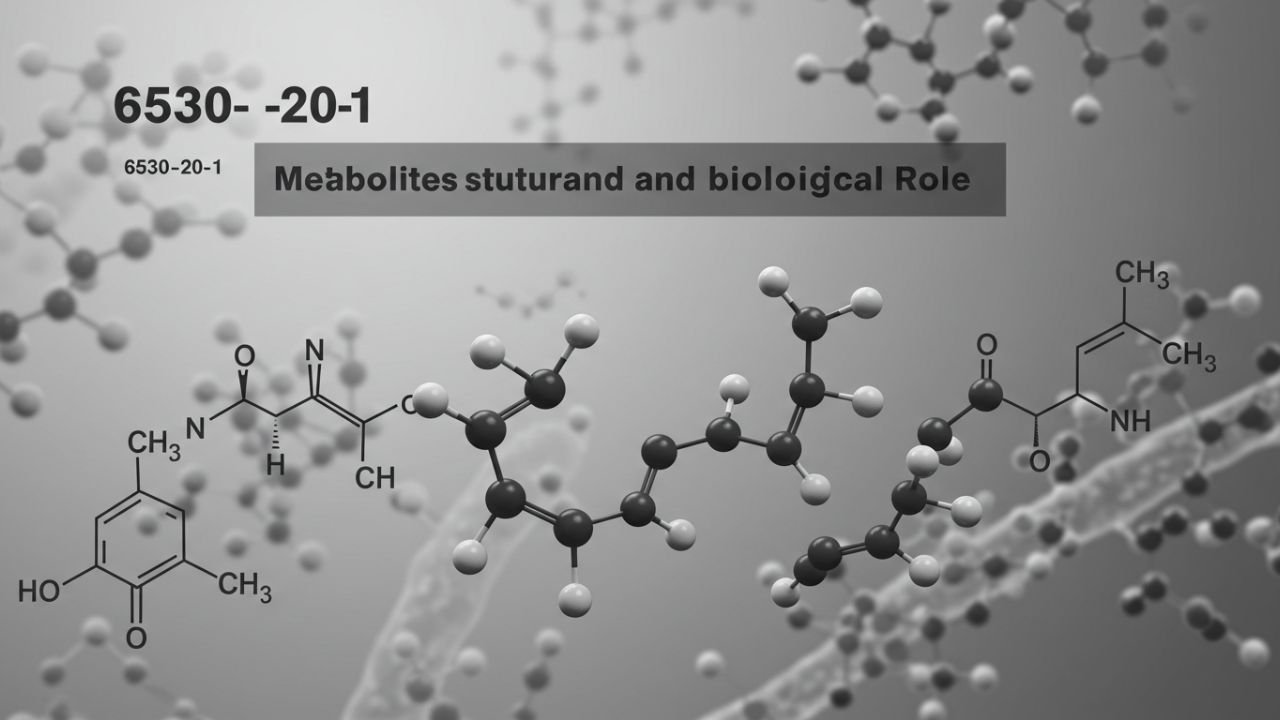Health
6530-20-1 Metabolites: Structure and Biological Role

Introduction to 6530-20-1 Metabolites
Metabolites play a crucial role in the intricate world of biochemistry, acting as the building blocks that fuel biological processes. Among these metabolites, 6530-20-1 stands out with its unique chemical properties and functions. Scientists have been delving into this compound to understand its potential applications and implications for health and medicine. Whether you’re a curious learner or an expert in the field, exploring 6530-20-1 metabolites offers fascinating insights into how our body operates at a molecular level. Join us on this journey as we uncover what makes 6530-20-1 metabolites so significant!
Chemical Structure of 6530-20-1 Metabolites
The chemical structure of 6530-20-1 metabolites is a fascinating aspect that reveals much about their functionality. These metabolites possess distinct molecular configurations that contribute to their biological activity.
Typically, the structure includes specific functional groups essential for interaction with biological targets. The arrangement of atoms within these compounds determines how they are metabolized and utilized by living organisms.
Moreover, stereochemistry plays a crucial role. Different spatial orientations can lead to variations in activity levels, influencing how effectively these metabolites function within various metabolic pathways.
Understanding this intricate chemical architecture helps researchers design targeted therapies and enhances our knowledge of metabolic processes. As scientists continue to explore these structures, we gain deeper insights into their roles in health and disease management.
Biological Role of 6530-20-1 Metabolites
The biological role of 6530-20-1 metabolites is multifaceted and intriguing. These compounds participate in various metabolic pathways, contributing to cellular functions essential for life.
One significant aspect is their involvement in energy production. They facilitate the conversion of nutrients into usable energy, ensuring cells function optimally.
Additionally, these metabolites play a critical role in signaling processes within the body. They can influence gene expression and modulate enzyme activity, impacting numerous physiological responses.
Moreover, it are known to aid in detoxification mechanisms. They help neutralize harmful substances, protecting cells from oxidative stress and damage.
Their presence also supports immune responses by regulating inflammation levels. This interaction highlights their importance not just at the cellular level but also for overall health maintenance.
Sources of 6530-20-1 Metabolites
6530-20-1 metabolites can be found in various natural sources. Certain plants and microorganisms produce these compounds during their metabolic processes.
In particular, some herbs are known to contain higher concentrations of it’s. This makes them valuable for both nutritional and medicinal purposes.
Additionally, fermentation processes involving specific bacteria or fungi often yield these metabolites. The complexity of microbial metabolism can lead to diverse profiles rich in beneficial substances.
Human biochemistry also plays a role. As the body breaks down certain foods, it produces 6530-20-1 metabolites as intermediates or end products.
Understanding where these metabolites come from is essential for harnessing their full potential in health and wellness applications. By exploring different sources, researchers can discover new ways to utilize these compounds effectively.
Medical Applications of 6530-20-1 Metabolites
6530-20-1 metabolites have garnered attention for their potential therapeutic applications. Research indicates they may play a role in managing metabolic disorders, making them significant in clinical settings.
These metabolites are being explored for their ability to influence cellular pathways and enhance metabolic functions. Their role in energy production could lead to novel treatments for conditions like obesity and diabetes.
Additionally, some studies suggest that 6530-20-1 metabolites might aid in cancer therapies. By targeting specific biochemical processes, they can potentially inhibit tumor growth or improve the efficacy of existing medications.
The pharmaceutical industry is keenly investigating these compounds. As research progresses, we may discover even more medical applications that harness the unique properties of 6530-20-1 metabolites for enhanced patient care and outcomes.
Potential Side Effects and Risks
While 6530-20-1 metabolites offer intriguing benefits, they are not without potential side effects. Users may experience gastrointestinal disturbances, including nausea and diarrhea. Such reactions can vary in severity depending on individual tolerance levels.
Additionally, some individuals might report fatigue or headaches after exposure to these metabolites. The body’s reaction can be quite personal and unpredictable.
It’s also vital to consider interaction with other substances. When combined with certain medications or supplements, the effects of it may change significantly.
Long-term use has raised concerns about liver function in some studies. Monitoring is essential for anyone considering prolonged consumption.
Always consult a healthcare professional before incorporating any new substance into your routine. Understanding both the benefits and risks is crucial for making informed decisions regarding health and wellness choices.
Conclusion
The exploration of 6530-20-1 metabolites reveals a complex interplay between chemical structure and biological function. Understanding their unique chemical characteristics helps scientists unlock the potential applications these metabolites hold in various fields, including medicine and biotechnology.
Their biological roles are crucial, influencing metabolic pathways that can be pivotal for health and disease management. As researchers continue to study sources rich in it, new opportunities arise for innovative treatments and therapeutic interventions.
However, awareness of potential side effects is essential as we delve deeper into harnessing these compounds’ full benefits. The journey through the world of it’s continues to evolve, promising exciting advancements on the horizon while emphasizing the need for careful consideration in their application.
Health
Nukleotidy: Their Role in DNA and RNA Functionality

Introduction to Nucleotides
Nukleotidy are the building blocks of life, playing a crucial role in the genetic makeup of all living organisms. These tiny molecules might seem insignificant at first glance, but they hold incredible power when it comes to DNA and RNA functionality. Understanding nucleotides can unlock mysteries about how our cells function and how traits are inherited.
As we dive deeper into this fascinating topic, we’ll explore what makes up these essential components, their importance in both DNA and RNA processes, and even how environmental factors influence their performance. Get ready to discover why nucleotides matter more than you ever imagined!
Structure and Components of Nucleotides
Nucleotides are the building blocks of nucleic acids, fundamental to life itself. Each nucleotide consists of three main components: a phosphate group, a sugar molecule, and a nitrogenous base. The phosphate group is key for linking nucleotides together. It forms bonds with the sugar of adjacent nucleotides, creating long chains essential for DNA and RNA structure.
The sugar component varies between DNA and RNA. In DNA, it’s deoxyribose; in RNA, it’s ribose. This subtle difference significantly impacts their function and stability.
Nitrogenous bases come in five varieties: adenine (A), thymine (T), cytosine (C), guanine (G), and uracil (U). These bases play an integral role in encoding genetic information through specific pairing rules. Together, these components create the unique structure that enables nucleotides to fulfill their vital roles within cells. Understanding this foundation opens doors to exploring how they contribute to life’s complexity.
Importance of Nucleotides in DNA Functionality
Nucleotides are the building blocks of DNA, playing a critical role in storing and transferring genetic information. Each nucleotide consists of a sugar, phosphate group, and nitrogenous base. This unique arrangement allows them to link together into long chains. The sequence of nucleotides encodes essential instructions for cellular activities. When cells divide, these sequences ensure accurate replication, preserving genetic integrity across generations.
Moreover, nucleotides contribute to the regulation of gene expression. They influence when genes are turned on or off, affecting everything from cell function to organism development. Through interactions with proteins and other molecules, nucleotides also participate in vital processes like repair mechanisms for damaged DNA. Their presence is indispensable for maintaining life as we know it. Without proper nucleotide functionality, organisms could face dire consequences at both cellular and systemic levels.
Role of Nucleotides in RNA Functionality
Nucleotides play a pivotal role in RNA functionality, serving as the building blocks for this essential molecule. Each nucleotide consists of a sugar, phosphate group, and nitrogenous base. The arrangement of these components determines how RNA carries out its functions.
In messenger RNA (mRNA), nucleotides encode genetic information from DNA, guiding protein synthesis in cells. This process is known as transcription, where mRNA serves as a template for assembling amino acids into proteins.
Transfer RNA (tRNA) relies on specific nucleotides to recognize codons on the mRNA strand. This recognition ensures that the correct amino acids are delivered during translation. Ribonucleic acid also plays roles beyond protein coding. Regulatory RNAs like microRNAs utilize nucleotide sequences to control gene expression and maintain cellular homeostasis. The versatility of nucleotides within RNA underpins countless biological processes vital for life’s continuity.
Common Types of Nucleotides and Their Functions
Nucleotides come in several types, each serving unique roles within biological systems. The two primary categories are purines and pyrimidines. Adenine and guanine belong to the purine family. Adenosine triphosphate (ATP), a well-known nucleotide, is crucial for cellular energy transfer.
Cytosine, thymine, and uracil represent pyrimidines. Thymidine is essential for DNA structure, while uridine plays a significant role in RNA synthesis. Some nucleotides also act as signaling molecules. Cyclic adenosine monophosphate (cAMP) influences various cellular processes by acting as a secondary messenger.
Additionally, some nucleotides participate in metabolic pathways. For instance, nicotinamide adenine dinucleotide (NAD+) is vital for redox reactions and energy production. Each type contributes significantly to genetic information storage or biochemical processes necessary for life’s functions.
How Environmental Factors Affect Nucleotide Functionality
Environmental factors play a crucial role in the functionality of nucleotides. Changes in temperature, pH levels, and ion concentrations can significantly impact nucleotide stability and activity. For instance, extreme temperatures may lead to the denaturation of DNA or RNA structures. This disrupts their ability to replicate accurately or perform essential cellular functions.
Additionally, variations in pH can alter hydrogen bonding patterns between nucleotides. These changes might affect enzyme interactions that are vital for transcription and replication processes. Moreover, exposure to toxins such as heavy metals or radiation can cause oxidative damage to nucleotides. Such damage compromises genetic integrity and can lead to mutations over time.
Nutrient availability is another environmental factor influencing nucleotide synthesis. A deficiency in key nutrients like folate impacts the production of nucleotides needed for DNA repair and cell division. Understanding these dynamics is essential for comprehending cellular health and function.
Conclusion
Nukleotidy, the building blocks of life, play a pivotal role in both DNA and RNA functionality. Their unique structures enable them to carry genetic information and facilitate essential biological processes. By understanding the intricate nature of these molecules, we gain insights into how they influence everything from protein synthesis to cellular metabolism.
The importance of nukleotidy transcends just their structural roles; they are also key players in energy transfer within cells. The interplay between different types can dictate various metabolic pathways and responses to environmental stimuli. This highlights not only their significance but also the delicate balance that sustains life.
As research continues, more is being uncovered about how environmental factors—such as temperature, pH levels, and nutrient availability—can affect nucleotide functionality. These findings underscore the dynamic relationship between our biology and external conditions.
Whether you’re delving into molecular biology or simply curious about what makes us who we are at a cellular level, recognizing the critical function of nukleotidy opens up endless avenues for exploration. Understanding these fundamental components can provide deeper insights into health, disease mechanisms, and even evolutionary biology. The journey through nucleotides reveals much about life’s complexity and interconnectedness.
Health
Understanding Treatments from a Children’s Orthodontist

Key Highlights
Here are the key takeaways about children’s orthodontic care: Early orthodontic treatment is often simpler and more comfortable for children. An early assessment, ideally between 6 and 10 years of age, helps identify potential issues before they become complex. The difference between a pediatric dentist and a children’s orthodontist is important to note: a pediatric dentist focuses on the overall dental health, hygiene, and development of children’s teeth, while a children’s orthodontist specializes specifically in the diagnosis, prevention, and correction of misaligned teeth and jaws through orthodontic treatment. Both work together to ensure comprehensive orthodontic care for young patients.
- Early orthodontic treatment is often simpler and more comfortable for children.
- An early assessment, ideally between 6 and 10 years of age, helps identify potential issues before they become complex.
- Early intervention can guide jaw growth and create space for incoming permanent teeth.
- Addressing habits like thumb sucking at a young age can prevent more significant problems later.
- Knowing the right time for your child’s first orthodontic visit provides peace of mind.
- Children’s orthodontics focuses on creating a healthy, confident smile for life.
Introduction
As a parent, you want the very best for your child, and that includes a healthy, beautiful smile. The world of children’s orthodontics is dedicated to ensuring that little smiles get big care. It’s about more than just straightening teeth; it’s about guiding the development of the jaw and face to support lifelong oral health. Understanding when and why to seek orthodontic care can make a significant difference as your child’s baby teeth give way to their permanent adult teeth, setting the foundation for a confident and healthy smile.
Children’s Orthodontics: Why Early Care Matters
Timing is crucial when it comes to your child’s dental health. For many children, early treatment allows an orthodontist to gently guide the growth of the child’s jaw. This proactive approach can create the necessary space for permanent teeth to erupt correctly, potentially simplifying or even eliminating the need for more extensive treatment later on.
This process, known as early intervention, focuses on addressing developmental issues while the jaw is still growing and more adaptable. By catching problems early, you can improve your child’s overall oral health and make their orthodontic journey a much more comfortable and effective experience.
Common Orthodontic Issues in Australian Children
Many parents wonder how to spot potential orthodontic issues. While crooked teeth are a common and obvious sign, several other conditions can indicate that a visit to an orthodontist would be beneficial for your child’s dental health.
Some of the most frequent orthodontic concerns seen in children include problems with their bite and jaw alignment. These issues can arise from genetics, habits like thumb sucking, or the early loss of baby teeth. A narrow upper jaw can also lead to crowding and other complications as permanent teeth emerge.
Here are a few common issues to look out for:
- Overbite or Deep Bite: The upper front teeth excessively overlap the lower front teeth.
- Underbite: The lower teeth and jaw sit in front of the upper teeth.
- Crossbite: Some upper teeth sit inside the lower teeth when biting down.
- Crowded or Protrusive Teeth: Not enough space in the jaw for teeth to fit properly.
Early Signs Your Child May Need an Orthodontist
Are you unsure if your child needs orthodontic attention? Spotting the early signs is key to timely intervention. Beyond simply looking at your child’s teeth, observing how they bite, chew, and even breathe can provide important clues about their jaw growth and dental development.
Sometimes, the premature or late loss of baby teeth can signal an underlying issue that requires a professional assessment. If you notice any of these signs, scheduling a consultation can help you get a clear treatment plan and peace of mind.
Watch for these early indicators:
- Difficulty chewing or biting
- Mouth breathing
- Speech difficulties
- Jaws that shift or make sounds
- Early or late loss of baby teeth
Benefits of Early Assessment and Treatment
An early orthodontic assessment benefits your child’s dental health by spotting potential issues while they’re still growing. This visit provides a clear plan for future needs, even if treatment isn’t needed yet.
Early, or interceptive, treatment corrects problems as they arise, making future orthodontic care easier and shorter. It works with your child’s natural growth for optimal results.
Key benefits:
- Guides jaw growth for a balanced facial profile
- Reduces the risk of injury to protruding front teeth
- Addresses harmful habits like thumb sucking
- Improves the eruption path of permanent teeth
When Should Children Visit an Orthodontist?
Knowing the right age for a first orthodontic visit can feel confusing. Is there a magic number? While every child’s development is unique, there is a general timeframe recommended by experts to ensure potential problems with jaw alignment and dental arches are spotted early.
A specialist orthodontist has the training to evaluate your child’s growth and development. This first visit is typically a simple check-up to assess how their teeth and jaws are forming, providing a baseline for their future needs. The following sections will explain the ideal timing and what influences the start of treatment.
Recommended Age for First Orthodontic Evaluation
The ideal age for a child’s first orthodontic evaluation is 6 to 10, when they have both baby and permanent teeth. This visit isn’t about starting braces, but rather assessing dental development and identifying early issues with jaw growth or tooth alignment that a general dentist might miss. Early evaluation allows for simpler, more effective treatment and helps you plan, ensuring your child gets the right care at the right time.
Factors That Influence Timing of Treatment
The ideal time to start orthodontic treatment varies for each child, depending on their individual development. The main goal is to begin treatment when it will be most effective.
Key factors include:
- Jaw Growth: Early treatment works best when the jaw is still growing, especially the upper jaw.
- Permanent Teeth Eruption: Some treatments require certain permanent teeth to be present.
- Dental Issue Severity: Severe bite problems or crowding may need earlier intervention.
- Oral Habits: Habits like thumb sucking should be addressed early to avoid further complications.
These factors help determine whether immediate action or a wait-and-see approach is best.
Types of Orthodontic Treatments for Kids
Today, orthodontic treatment offers more variety than ever before. Gone are the days when one type of braces fits all. Modern orthodontics provides a range of treatment options designed to suit your child’s specific needs, lifestyle, and comfort level, all while working toward a beautiful smile.
From traditional methods that have been trusted for decades to newer, more discreet technologies, there is a solution for nearly every situation. Understanding these choices can help you and your child feel more confident and prepared for the journey ahead. The following sections will explore some of the most common treatments available.
Traditional Braces for Children
When you think of orthodontics, traditional braces are likely the first thing that comes to mind. This tried-and-true method remains one of the most effective tools for correcting a wide range of orthodontic issues, from simple crooked teeth to more complex bite problems. A children’s orthodontist will use brackets and wires to gently apply pressure, moving teeth into their ideal positions over time.
While they are highly visible, modern braces are smaller and more comfortable than ever before. They give the orthodontist precise control over tooth movement, making them an excellent choice for achieving a great result and improving long-term oral health. Your orthodontist will create a detailed treatment plan tailored to your child’s needs.
It’s normal for your child to feel some mild discomfort for a few days after the braces are fitted, but this typically subsides quickly. Regular adjustments are a key part of the process, ensuring the treatment stays on track.
Clear Aligners and Other Modern Options
For parents and kids looking for a more discreet alternative to braces, clear aligners like Invisalign offer a fantastic solution. These custom-made, transparent trays fit snugly over the teeth, gently shifting them into place. Because they are nearly invisible, they are a popular choice, especially as children move into their teenage years.
A major advantage of clear aligners is that they are removable. This allows your child to eat, brush, and floss as they normally would, making it easier to maintain good oral hygiene throughout the treatment plan. The aligners are swapped out every one to two weeks to continue the movement of the permanent teeth.
While not suitable for every case, modern options provide great flexibility. Here are some benefits:
- Virtually invisible appearance
- Removable for eating and cleaning
- Comfortable with no metal brackets or wires
- Fewer orthodontic appointments in some cases
Specialized Appliances for Young Patients
In some cases, early treatment involves more than just braces or aligners. Specialized appliances are often used for young patients to address underlying structural issues in the jaw and mouth while they are still growing. These devices play a crucial role in interceptive orthodontics, helping to prevent more complex problems from developing.
For example, palatal expanders are used to widen a narrow upper jaw, creating more space for crowded teeth. Functional appliances help guide jaw growth to correct bite issues like overbites, while space maintainers hold a spot open for a permanent tooth if a baby tooth is lost too early.
These appliances are key to successful early treatment and can make a significant difference in a child’s overall outcome. Common types include:
- Palatal Expanders: Widen the upper jaw.
- Space Maintainers: Preserve space for unerupted permanent teeth.
- Functional Appliances: Encourage or redirect jaw growth.
Conclusion
In summary, understanding the role of a children’s orthodontist is essential for ensuring your child’s dental health and development. Early intervention can prevent more severe issues down the line, guiding your child toward a healthier smile. From recognizing early signs of orthodontic needs to exploring various treatment options, being proactive can lead to significant benefits. Remember, the journey to a beautiful smile starts with the first visit. If you’re considering an evaluation for your child, don’t hesitate to reach out for guidance—your child’s smile deserves the best care!
Frequently Asked Questions
Will my child’s orthodontic treatment hurt?
It is normal for your child to experience some mild discomfort or soreness for a few days after their braces are first fitted or adjusted. However, the initial placement does not hurt. This temporary feeling can be managed with over-the-counter pain relievers and will subside as your child gets used to their new appliance.
How long does orthodontic treatment usually last for kids?
The duration of orthodontic treatment varies widely for each child. It can range from a few months of treatment for simple issues to a couple of years for more complex cases. Factors like the type of treatment options used, the severity of the problem, and how well your child follows instructions all influence the timeline.
Are there benefits to starting treatment early?
Yes, absolutely. Early treatment allows an orthodontist to guide jaw growth, correct harmful habits, and create space for permanent teeth. This early intervention can simplify or even eliminate the need for more complex treatment later on. An early orthodontic assessment helps identify potential issues when they are easiest to manage.
Health
Discovering the Benefits of Cannabis Clinic Adelaide

Key Highlights
- Access medicinal cannabis services easily through a telehealth consultation anywhere in South Australia.
- Receive a personalized treatment plan from experienced and authorized prescribing doctors.
- Benefit from dedicated patient care in a judgment-free and confidential environment.
- Enjoy the convenience of a 100% online process, from intake to follow-up support.
- Get your approved medication delivered securely and discreetly to your home.
- Book your appointment without needing a referral from your general practitioner.
Introduction
Are you exploring new avenues for your health and wellness in South Australia? Finding the right support can make all the difference. A cannabis clinic can offer a modern and personalized approach to managing your health concerns. If you’re looking for accessible and expert care, Cannalink Clinic provides professional telehealth services for medicinal cannabis across Adelaide and the wider region. Our focus is on delivering quality healthcare that fits your lifestyle, ensuring you feel heard and supported throughout your journey.
Understanding Cannabis Clinics in Adelaide
Navigating the world of alternative therapy can sometimes feel overwhelming, but a specialized cannabis clinic in Adelaide simplifies the process. These clinics are dedicated to providing quality healthcare focused on medicinal cannabis. Doctors who prescribe medicinal cannabis in Adelaide work within these clinics to offer expert guidance and prescriptions.
Cannalink Clinic stands out as an alternative health clinic that prioritizes personalized care. Through our telehealth platform, you can connect with authorized prescribing doctors who are experienced in creating tailored treatment plans, making it easier than ever to access this form of care.
What Sets Adelaide Cannabis Clinics Apart
When you choose a cannabis clinic in Adelaide, you’re looking for more than just a prescription; you want a partner in your health journey. The best clinics are defined by their commitment to quality healthcare and patient-centric services. Cannalink Clinic exemplifies this by offering a comprehensive range of services entirely online, from the initial consultation to ongoing support.
Our dedicated clinical team takes the time to understand your unique situation. This focus on listening and providing personalized care is what many consider an award-winning quality in healthcare. We believe that modern, ethical, and judgment-free support should be the standard for every patient.
This commitment to excellence ensures you receive a high level of service without ever having to leave your home. The entire process is designed around your convenience and well-being, setting a new standard for alternative health in Adelaide.
The Role of Medical Cannabis in Daily Wellness
Medicinal cannabis is becoming an increasingly recognized option for managing daily wellness. Its potential to support various medical conditions makes it a valuable alternative health solution for many people. The use of medicinal cannabis is often considered for those dealing with chronic issues that haven’t responded to conventional treatments.
At Cannalink Clinic, we see patients seeking support for a wide range of concerns, including chronic pain, sleep disorders, and certain mental health conditions. If you have been living with a particular condition for three months or more, you may be eligible for medicinal cannabis treatment.
Our doctors specialize in creating plans that integrate medicinal cannabis into a broader wellness strategy. The goal is to improve your quality of life by offering a natural and personalized approach to your health management.
How to Access Medicinal Cannabis Services
Getting started with medicinal cannabis services is a straightforward and supportive process. It begins with an initial consultation to determine if this treatment is right for you. Our clinical team reviews your medical history and discusses your symptoms to develop a personalized treatment plan.
Thanks to modern telehealth services, you can access this care without leaving your home. The entire consultation process is handled online, providing a convenient and confidential way to connect with our doctors. Let’s look at how you can book your appointment and what to expect.
Booking a Consultation at Cannalink Clinic
Booking your first consultation at Cannalink Clinic is designed to be simple and stress-free. The entire process is managed online, making it accessible to everyone in Adelaide and across South Australia. You can start your journey toward better health in just a few clicks.
The process begins when you complete a short online intake form, which takes less than five minutes. This form gathers basic information about your medical history and current symptoms. After you submit the form, our clinical team conducts a free online screening to confirm your eligibility.
Once you are approved, we will contact you to schedule your online consultation with one of our experienced doctors. The steps are easy to follow:
- Fill out the short online intake form.
- Undergo a free online screening by our clinical team.
- Book your telehealth call for your first consultation.
- Discuss a personalized treatment plan with a doctor.
Eligibility for Medicinal Cannabis Treatment
Curious if you qualify for medicinal cannabis treatment? Eligibility is generally determined by your medical history and the nature of your condition. If you have a particular condition that has persisted for at least three months and has not been effectively managed by conventional treatments, you may be a candidate.
Our clinic maintains upfront and transparent pricing, so you always know what costs to expect. The first step is to complete our free online screening, which helps our team assess your situation. Let’s explore some of the common conditions we treat and how we can support you.
Common Conditions Treated at Cannalink Clinic
At Cannalink Clinic, we provide support for various medical conditions, with a focus on personalized care. Our experienced doctors create a tailored treatment plan based on your specific needs, whether you’re dealing with physical discomfort or mental health challenges.
We understand that every patient is unique, which is why we take the time to listen and develop a plan that works for you. Our goal is to improve your overall well-being and quality of life.
Here are some of the common areas we provide support for:
| Condition Category | Examples |
| Chronic Pain | Pain from injury, illness, or other sources |
| Sleep Disorders | Insomnia and other sleep-related issues |
| Mental Health | Anxiety, stress, and related conditions |
| Other Conditions | Various other ongoing health concerns |
Do You Need a Referral for Your Consultation?
One of the most common questions people ask is whether they need a referral from their GP. At Cannalink Clinic, you do not need a referral to book a consultation. We have streamlined the consultation process to make it as easy as possible for you to access the care you need.
Simply complete our quick online screening form, and our team will get in touch to organize your appointment with a medical practitioner. This direct approach removes a significant barrier, allowing you to take proactive steps toward managing your health without unnecessary delays.
By eliminating the need for a referral, we put you in control of your health journey. You can start the process of creating a personalized treatment plan today, often with same-day appointments available for many of our new patients.
Alternative Medicine and Holistic Care
Alternative medicine and holistic care are about treating the whole person, not just the symptoms. This approach, often called integrative health, combines different therapies to support your overall well-being. Cannalink Clinic embraces this philosophy by providing access to quality alternative medicine.
Our services go beyond just medicinal cannabis to include a range of alternative health therapies tailored to your needs. We believe that a holistic approach can lead to better treatment results and a more balanced life. Let’s look at how we integrate these methods into our care.
Integrative Approaches Used at Cannalink Clinic
At Cannalink Clinic, our treatment approach is rooted in integrative principles. We believe in harnessing the power of natural therapies to complement medicinal cannabis treatment. Our clinical team works with you to create a holistic plan that addresses your physical, mental, and emotional health.
This method allows us to provide a more comprehensive form of alternative medicine. Instead of focusing on a single solution, we explore how different strategies can work together to enhance your well-being. This might include lifestyle guidance and other supportive measures.
Our doctors are experienced in a variety of integrative approaches and are dedicated to finding the right combination for you. This personalized strategy ensures that your care is as unique as you are, helping you achieve the best possible outcomes.
Supporting Your Journey Beyond Cannabis
Your health journey doesn’t end after your first consultation, and neither does our support. We are committed to providing ongoing patient care to help you track your treatment results and make any necessary adjustments. Consistent follow-up is a key part of our service.
You will always work with the same trusted team, ensuring continuity of care. This allows us to build a strong relationship with you and better understand your progress over time. Whether you need a script renewal or want to discuss your experience with an alternative therapy, we are here to help.
This commitment to long-term support ensures you never feel alone. From your initial appointment to every follow-up, our team is dedicated to guiding you and helping you achieve your wellness goals.
Frequently Asked Questions (FAQ)
Understanding how cannabis clinics operate can be simplified through frequently asked questions. Patients often inquire about the consultation process, which typically starts with a short online intake form. This helps the clinical team assess individual medical history and tailor a treatment plan. Many ask about telehealth consultation options, allowing for confidential discussions about their particular conditions from the comfort of their homes. Other common concerns include the side effects of medicinal cannabis products and the prescribing process for concession card holders under the Pharmaceutical Benefits Scheme.
Can I get a medicinal cannabis prescription through telehealth?
Yes, you can. Through our dedicated telehealth services, you can have a telehealth appointment with an authorized medical practitioner who can assess your eligibility. If medicinal cannabis is deemed suitable for you, your doctor can issue a telehealth prescription directly, making the entire process convenient and accessible.
What is the process for starting treatment?
The consultation process begins with a free online screening. Our clinical team will review your medical history and personal circumstances. Afterward, you’ll have a telehealth consultation with a doctor to discuss a personalized treatment plan tailored to your specific needs and health goals.
Are there ongoing support options after the first visit?
Absolutely. We provide comprehensive ongoing support to ensure your treatment remains effective. Your dedicated clinical team is available for follow-up appointments to adjust your treatment plan as needed. This commitment to patient care is a core part of our approach to alternative health and your long-term well-being.
Conclusion
In conclusion, exploring the benefits of cannabis clinics in Adelaide can lead to a positive shift in your approach to health and wellness. With a focus on personalized care and a variety of treatment options, Cannalink Clinic stands out as a reliable resource for those seeking medicinal cannabis solutions. By understanding how to access these services and learning about eligibility, you empower yourself to take charge of your health journey. Embrace the holistic approaches offered and consider how they can support your overall well-being. If you’re ready to explore the potential of cannabis in enhancing your quality of life, don’t hesitate to book a consultation with Cannalink Clinic.
Health
What to Expect During a General Dentistry Check-Up

Regular dental visits play a critical role in maintaining oral health, yet many people feel uncertain about what actually happens during a check-up. Understanding the process can help reduce anxiety and encourage more consistent dental care. A general dentistry check-up is more than just a cleaning; it involves a comprehensive evaluation of your oral health to identify potential issues early, promote preventive care, and provide personalized recommendations tailored to your specific needs. We will explore the typical steps involved, what patients can expect, and why these visits are essential for long-term dental health and wellness. Knowing what to expect can make the experience smoother, less stressful, and more productive for maintaining a healthy smile.
What Happens During a General Dentistry Check-Up
1. Initial Consultation and Medical History Review
Every dental check-up begins with a conversation between the dentist and the patient. At our dental practice, the initial consultation involves a thorough review of your medical history, including any chronic conditions, current medications, and allergies, as these factors can impact dental treatment. This discussion also includes questions about your oral habits, such as brushing, flossing, and diet, as well as any current concerns like sensitivity, pain, or discomfort. By understanding your overall health and lifestyle, the dentist can tailor the check-up to focus on areas that may require extra attention. Providing accurate and complete information helps ensure that the dentist can detect underlying conditions that may affect your oral health. This stage sets the tone for a thorough and effective evaluation.
2.Visual Examination of Teeth and Gums
Following the consultation, the dentist will conduct a visual examination of your mouth, teeth, gums, and surrounding tissues. Using specialized tools and proper lighting, the dentist examines the teeth for signs of decay, gum disease, enamel erosion, and other abnormalities. This includes examining for cavities, plaque buildup, gum inflammation, or irregularities that may indicate more significant issues. The dentist may also examine the alignment of your teeth, bite patterns, and the condition of any existing dental work, such as fillings or crowns. A visual check is an essential step because it allows the dentist to detect early signs of problems before they become more severe and require invasive procedures. Patients often do not realize the extent of information a thorough visual inspection can reveal about their overall oral health.
3.Dental X-Rays and Imaging
In many check-ups, dental X-rays or other imaging techniques are used to get a more detailed view of your teeth, roots, and jawbone. X-rays can detect cavities between teeth, bone loss, impacted teeth, and other conditions that are not visible during a visual examination. This imaging is essential for creating a complete picture of your oral health and planning any necessary treatments. Modern dental practices use digital X-rays, which reduce radiation exposure and provide immediate results for analysis. While some patients may feel apprehensive about X-rays, they are a safe and vital part of comprehensive dental care. The information gained from imaging ensures that potential issues are identified early, allowing for prompt intervention and better long-term outcomes.
4.Professional Cleaning and Polishing
A significant component of a general dentistry check-up is professional cleaning, which removes plaque and tartar buildup that regular brushing and flossing cannot fully address. During cleaning, the dental hygienist uses specialized tools to scrape away hardened deposits on the teeth and under the gumline. This process helps prevent cavities, gum disease, and bad breath. Following the cleaning, the teeth are polished to smooth the surfaces, making it harder for plaque to accumulate. Some practices may also apply fluoride treatments to strengthen enamel and protect against decay. Patients often notice an immediate difference after cleaning, with their teeth feeling smoother and their gums appearing healthier. This step not only enhances oral hygiene but also reinforces preventive care habits by demonstrating the importance of regular maintenance.
5.Assessment of Oral Health Risks
After cleaning, the dentist assesses your risk factors for various dental conditions. This includes evaluating lifestyle habits, such as diet, smoking, or teeth grinding, that can contribute to dental problems. The dentist may also look at signs of oral cancer or other health issues that manifest in the mouth. Based on this assessment, personalized recommendations are provided to improve oral hygiene, adjust habits, or schedule follow-up treatments as necessary. Understanding your individual risk factors empowers you to take a more proactive approach to dental care. By addressing potential issues early, you can prevent more serious complications and maintain healthier teeth and gums in the long run.
Regular general dentistry check-ups offer a comprehensive approach to oral healthcare that extends far beyond routine cleaning. By understanding what to expect, patients can approach each visit with confidence and clarity, knowing that every step is designed to detect, prevent, and effectively manage potential dental issues. From the initial consultation and visual examination to X-rays, cleaning, risk assessment, patient education, and follow-up planning, every part of the process contributes to a healthier mouth and overall well-being. Proactive care not only maintains the appearance of your smile but also supports long-term dental health.
Visiting a dentist for a general check-up is a vital component of maintaining good oral health and preventing more serious complications. The process involves multiple steps, each designed to thoroughly evaluate the condition of your teeth, gums, and overall mouth health. From reviewing medical history and performing visual examinations to X-rays, professional cleaning, risk assessments, and patient education, each phase ensures that potential issues are identified early and addressed appropriately. By understanding what to expect during a general dentistry check-up, patients can feel more prepared, less anxious, and more engaged in their dental care journey. Regular check-ups create a foundation for a healthy, confident smile that can last a lifetime.
Health
How shoulder replacement can transform daily life after years of pain

Chronic shoulder pain can severely limit daily activities, affecting sleep, mobility, and overall well-being. For patients with advanced arthritis, degenerative joint disease, or complex fractures, shoulder replacement surgery in Turkey offers a transformative solution, replacing damaged joint structures with precision-engineered prostheses to restore function, reduce pain, and improve quality of life.
Understanding shoulder replacement surgery
Shoulder replacement, or shoulder arthroplasty, is a surgical procedure designed to replace the damaged parts of the shoulder joint with artificial components called prostheses. It is typically recommended for people suffering from severe arthritis, degenerative joint disease, or fractures that cannot be repaired through other treatments.
There are several types of shoulder prostheses, depending on the patient’s condition:
- Total shoulder replacement: replaces both the ball (humeral head) and the socket (glenoid).
- Partial shoulder replacement: replaces only the damaged ball.
- Reverse shoulder replacement: used when the rotator cuff tendons are too weak or torn.
By restoring smooth joint movement, these implants help relieve pain and improve shoulder function, allowing patients to regain mobility and return to normal daily activities.
The recovery journey
Recovery from shoulder replacement surgery is gradual but effective. Physical therapy begins shortly after surgery, focusing initially on gentle movements and pain management. Over the following weeks, patients progress to range-of-motion exercises and strength training to rebuild muscle support around the joint.
A typical recovery timeline may include:
- Early recovery (Weeks 1–3): Pain control and light arm mobility exercises.
- Intermediate phase (Weeks 4–8): Regaining flexibility, strength, and functional use of the arm.
- Functional phase (Months 2–4): Performing daily activities independently, including dressing, cooking, and light overhead tasks.
- Full recovery (6 months and beyond): Returning to a normal lifestyle and low-impact sports such as swimming, cycling, or yoga.
Beyond physical recovery, patients often experience significant improvements in emotional well-being, confidence, and independence, regaining the ability to participate in social and professional activities without limitations.
Why Turkey is an ideal destination for shoulder replacement
Turkey has emerged as a global leader in orthopedic surgery, offering a combination of world-class expertise, advanced technology, and cost-effective care. Major hospitals in Istanbul, Ankara, and Izmir are internationally accredited and equipped with state-of-the-art imaging systems, minimally invasive surgical tools, and high-precision robotic assistance.
The country’s orthopedic surgeons are highly trained, many with international experience, and specialize in advanced joint replacement techniques. This expertise ensures that patients benefit from the latest surgical innovations while receiving personalized, patient-centered care.
The role of a medical travel specialist
For international patients, navigating a surgical journey abroad can be complex. Collaborating with a medical travel specialist in Turkey ensures that every step—from initial consultation to post-surgical follow-up—is efficiently coordinated. These specialists handle medical appointments, hospital logistics, travel arrangements, and language support, providing patients with reassurance, safety, and convenience.
Long-term benefits and patient outcomes
Modern shoulder replacement surgeries offer excellent long-term outcomes. Studies show that over 90% of implants remain functional after 10 years, with low rates of complications. Patients experience significant improvements in pain relief, joint stability, and daily function. Many also regain the ability to participate in recreational activities and sports that were previously impossible due to pain or limited mobility.
Conclusion
Shoulder replacement surgery in Turkey provides a life-changing opportunity for patients suffering from chronic pain and restricted mobility. By combining cutting-edge surgical techniques, highly skilled surgeons, and the support of a medical travel specialist, patients can experience a smooth, safe, and transformative journey toward restored independence and quality of life. Turkey’s advanced orthopedic care ensures that recovery is not only effective but also comfortable, accessible, and personalized for each patient.
Health
Top 5 Contact Lenses to Enhance Green Eyes

Green eyes are one of the most captivating and rare eye colors, often associated with mystery, beauty, and allure. Many individuals with green eyes desire to highlight their eye color further or explore different shades for a new look. The good news is that modern contact lenses provide an excellent way to enhance your natural beauty, whether you want to make your green eyes pop or experiment with subtle or dramatic effects. In this article, we explore the top five contact lenses designed to beautifully enhance green eyes, helping you achieve your desired appearance confidently and comfortably.
1. Clear Daily Contact Lenses for Natural Enhancement
The first option for enhancing green eyes is to opt for clear daily contact lenses. These lenses are designed to be worn for a day and discarded, offering maximum convenience and hygiene. While they are primarily corrective, many brands incorporate subtle tinting that enhances the natural green hues of your eyes without drastically changing their appearance.
Using clear lenses allows you to enjoy the benefits of contact lens wear while maintaining a natural look. They are ideal for everyday wear, providing comfort and ease of use. If you’re considering this option, remember to buy contact lenses online from reputable sources to ensure quality and proper fit. These lenses also minimize the risk of dryness, especially when combined with the use of dry eye drops if needed.
2. Colored Contact Lenses for a Vibrant Green Effect
For those seeking a more striking transformation, colored contact lenses are an excellent choice. These lenses come in a variety of shades and patterns specifically designed to accentuate green eyes. Whether you want a brighter, more vivid green or a nuanced, natural look, there are options to suit your preference.
Colored lenses can dramatically change your appearance, making your green eyes look more intense or shifting to a different shade altogether. For example, some lenses add a ring around the iris to create a more defined and captivating gaze. When choosing colored lenses, it’s essential to select high-quality products that are comfortable and safe for your eyes. Always ensure you follow proper lens care routines and consult with an eye care professional if you experience any discomfort or dryness. If you’re interested, you can explore a wide selection of colored contact lenses and buy contact lenses online from trusted vendors.
3. Enhancement Tints for Subtle Brightening
Enhancement tint lenses are a popular choice for individuals with green eyes who want a subtle yet effective way to make their eye color stand out. These lenses are lightly pigmented and designed to enhance the natural hue of your eyes without completely changing their appearance. They are perfect for everyday use and for those who prefer a more natural look.
Enhancement tints work by boosting the existing green tones, making your eyes appear brighter and more vibrant. This effect is especially noticeable in good lighting conditions and can add a touch of glamour to your overall look. If you’re concerned about dryness, remember to use dry eye drops to keep your eyes comfortable throughout the day. These lenses are widely available, and you can easily find high-quality options by browsing online retailers.
4. Patterned Lenses for a Unique and Dramatic Look
Patterned contact lenses are designed to create unique effects, ranging from subtle enhancements to bold, theatrical styles. They often feature intricate designs, such as multi-toned rings, flecks, or exotic patterns that can make your green eyes truly stand out. These lenses are popular for special occasions, costume events, or for those who enjoy experimenting with different looks.
For a natural yet eye-catching enhancement, choose patterned lenses that blend seamlessly with your natural eye color. They can add depth and dimension, making your eyes appear larger and more luminous. As with all contact lenses, ensure you purchase from reputable sources and follow proper hygiene practices. If you want to explore different exciting options, you might consider trying patterned lenses that complement your green eyes and bring out their natural beauty.
5. Custom-Laminated Lenses for a Personalized Touch
The latest in contact lens technology includes custom-laminated lenses that offer a personalized enhancement based on your specific eye color and shape. These lenses are crafted to complement your natural green eyes, providing a tailored look that enhances your features without looking artificial. They can be designed to add subtle highlights, deepen the green hue, or introduce a slight shimmer effect.
Custom lenses are an excellent choice for those who want a bespoke appearance, perfect for special occasions or everyday wear. They also tend to be more comfortable and provide a more natural feel. When considering custom lenses, consult with an eye care professional who can guide you through the process and ensure you select the best option for your needs.
Final Tips for Enhancing Your Green Eyes with Contact Lenses
No matter which type of contact lenses you choose, a few essential tips can help you enjoy the best experience. Always prioritize eye health by buying contact lenses online from reputable sources, ensuring that your prescriptions are up-to-date. Proper lens hygiene is critical; follow cleaning and storage instructions carefully to prevent infections and discomfort.
If you experience dryness or irritation, incorporating dry eye drops into your routine can significantly improve comfort. These products help maintain moisture and prevent dryness, especially during extended wear or in dry environments. For additional guidance and options, you can explore dry eye drops suitable for contact lens wearers.
Finally, regular eye check-ups are vital to monitor your eye health and ensure that your lenses fit correctly. An eye care professional can advise you on the best lenses to enhance your green eyes while keeping them healthy and comfortable.
Conclusion
Enhancing green eyes with contact lenses offers a versatile way to elevate your look, whether you prefer a natural glow or a bold transformation. The top five options—ranging from clear daily lenses to custom-designed enhancements—provide a spectrum of choices to suit any style or occasion. Remember to prioritize eye health by purchasing from trusted sources, practicing good hygiene, and using products like dry eye drops when needed. With the right lenses and care, your green eyes can truly become your most captivating feature.
-

 Tech1 day ago
Tech1 day agoSimpcit6: A Complete Guide to Its Features, Benefits, and Applications
-

 Blog3 months ago
Blog3 months agoThe Role of i̇ns in Digital Communication: Enhancing Your Online Presence
-

 Entertainment2 months ago
Entertainment2 months agoмаријин трг: A Complete Guide to the Famous Square
-

 Home improvement2 months ago
Home improvement2 months agoTop Ways to Style a Round Jute Rug in Small Rooms
-

 Blog2 months ago
Blog2 months agoWhy Fesbuka is the Next Big Thing in Social Networking
-

 Blog3 months ago
Blog3 months agoWhat Is Hothaylost? Everything You Need to Know
-

 Blog3 months ago
Blog3 months agoDympigal: A Comprehensive Guide to Its Features and Applications
-

 Blog2 months ago
Blog2 months agoSimpcitu Explained: A Simple Yet Powerful Concept
